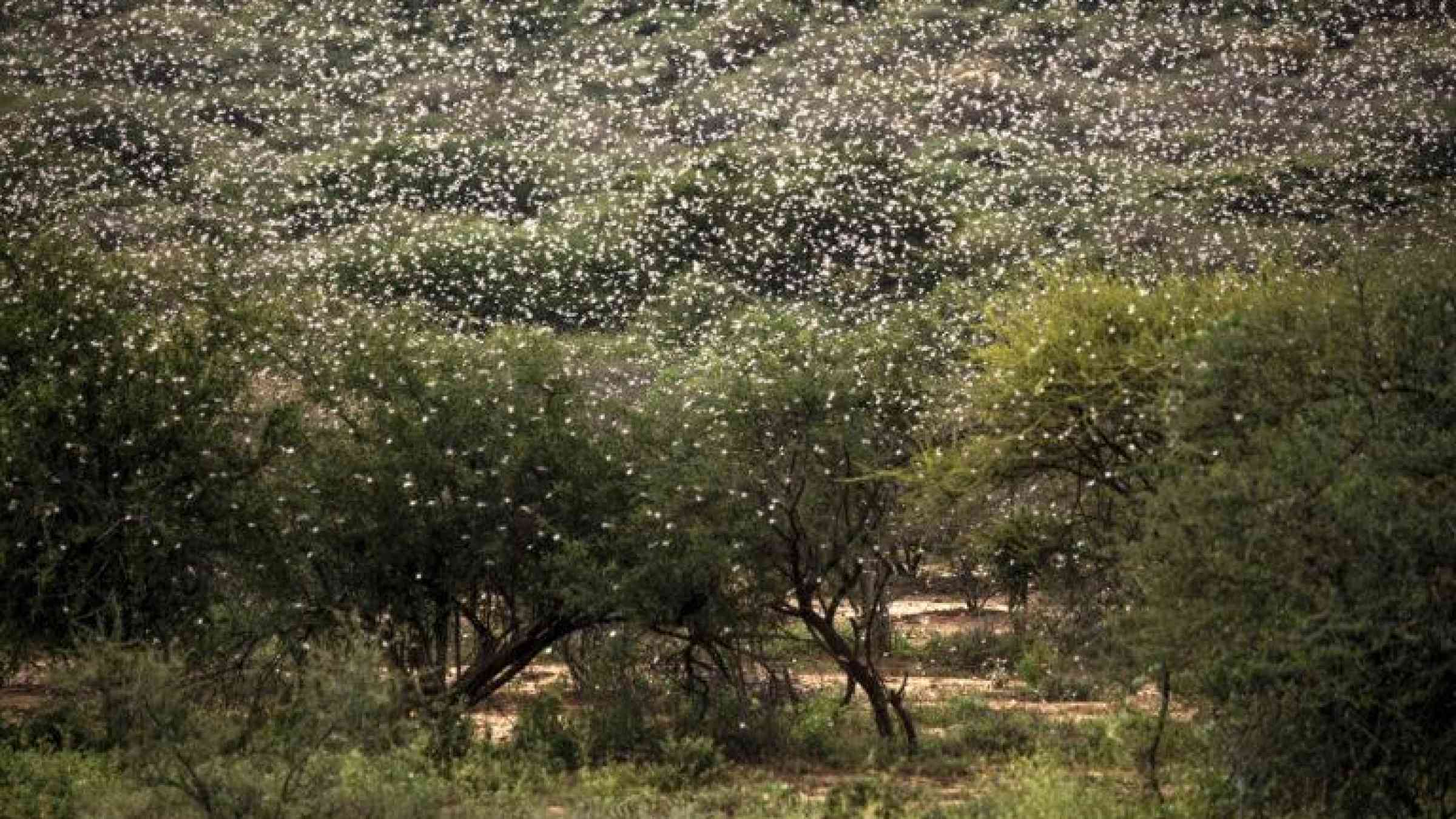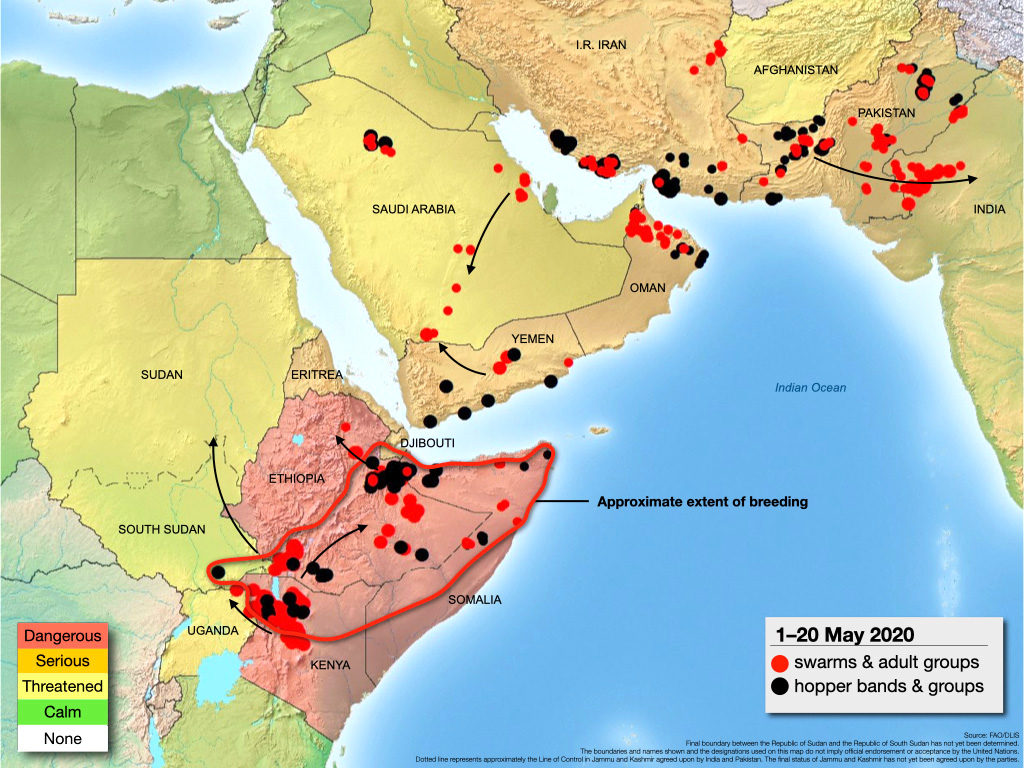
By Soumya Sarkar
- The largest locust swarm in close to three decades is eviscerating farmlands in western and northern India, spreading panic among farmers getting ready to sow the country’s main summer crop.
- The warming of the Indian Ocean due to climate change is cited as the main reason for the proliferation of locusts that are now ranging from the horn of Africa to the Arabian Peninsula to the Indian subcontinent.
- Since the spring harvest was gathered before the locust plague, there has been no extensive crop damage, but such swarming is more likely in the future, prompting calls for preventive and containment strategies.
Even as India grapples with the coronavirus pandemic, the country has been hit by a new pestilence in the form of large locust swarms. In the biggest attack in close to 30 years, millions of locusts are swarming across western and northern India, destroying farms and raising alarm ahead of the main summer cropping season.
So far, 41 districts spread across five states — Rajasthan, Gujarat, Maharashtra, Madhya Pradesh and Uttar Pradesh — have reported sightings of the insects, and many more districts could see swarm attacks in the next few weeks. Provincial governments in Delhi, Haryana, Himachal Pradesh, Uttarakhand, Telangana and Karnataka have sounded alerts.
The central government has issued an unprecedented locust warning to 16 states and has readied a fleet of air force helicopters to spray pesticides to kill the insects. Despite the Covid-19 lockdown, locust control offices are working since April 11 with 50 spray machines in coordination with various district administration and state agriculture department, the federal farm ministry said in a statement.
“Tractor mounted sprayers and fire-tender vehicles deployed at various locations are being used in locust control,” the ministry said. India has also ordered 60 new spraying machines from the United Kingdom that are scheduled to arrive soon, according to K.L. Gurjar, deputy director at India’s Locust Warning Organization (LWO), a unit that functions under the agriculture ministry.

Warning of successive waves
Compared with the locust attacks in the Horn of Africa, the swarms in India are still relatively small and they are most likely to remain so, according to Keith Cressman, senior locust forecasting officer at the Food and Agriculture Organization (FAO) of the United Nations. “Nevertheless, several successive waves of small swarms are likely to appear throughout the coming months in Rajasthan, some of which could continue to move eastwards ahead of the advancing monsoon,” he said.
The locust sightings have been much earlier than usual in India, most likely because their population increased significantly in Pakistan and Afghanistan. This could spell trouble for India since the swarms can double back to the Thar Desert that straddles India and Pakistan and spawn the next generation of locusts in much larger numbers that could destroy the main summer crop, experts said.
“Much depends on the effectiveness of control operations and the rains and (summer) growing season this year,” Cressman said.
Despite panic reactions in some areas, the situation is not yet beyond control. “The Locust Warning Organization of the Indian government is the oldest national locust program in the world. They are very well prepared with the necessary expertise and equipment for managing the desert locusts,” Cressman said. “In January, FAO first alerted officials and met with them to discuss anticipatory actions, which the government has been actively pursuing since then in preparing for the potential arrival of desert locust.”
Swarms are forming in the spring breeding areas and migrating east to the India-Pakistan border ahead of the monsoon rains, the FAO said in its latest locust update on May 27. “Several successive waves of invasions can be expected until July in Rajasthan with eastward surges across northern India as far as Bihar and Orissa, followed by westward movements and a return to Rajasthan on the changing winds associated with the monsoon,” The FAO bulletin said. “These movements will cease as swarms begin to breed and become less mobile.”
The current upsurge was initiated by two cyclones in the western Indian Ocean in 2018, according to Cressman. “We have noticed an increase in the number of cyclones in the past half dozen years. Cyclones are known to initiate desert locust plagues in the past,” Cressman said.
Piranhas of the skies
Locusts, a species of short-horned grasshoppers, have often been called piranhas of the skies. A single locust can eat its own body weight in food, which is about 2-2.5 grams. Since they fly in swarms, millions of individual insects operate as a gigantic eating machine that can decimate large areas in a matter of days. A swarm measuring 1 sq. km can eat as much food as 35,000 people in one day, according to FAO’s Locust Information Service.
Locusts lay eggs in sacks of 50 to 100 each. Locusts eggs are extremely resilient and have been known to lay dormant for a few weeks before hatching in favourable conditions. Once they hatch, the wingless larvae mature into adolescent hoppers in about two weeks, a time period that can be significantly shorter if there’s moisture in the air.
Once they grow wings, locusts form swarms that can cover 150 km in a single day. Typically, they reach sexual maturity in three months, which means there can be up to four generations every year. Since they can multiply by a factor of 20 to 100 every generations, swarms can number into billions in a matter of months.
There was unprecedented rainfall in eastern African and the Middle East in the summer of 2018. Locust eggs that were dormant in the deserts of these regions suddenly came to life. Initially, this hatching went undetected because it happened deep in the deserts. Soon the hatcheries in the deserts of Oman and the usually dry jungles of Kenya clustered together to form a super swarm.
This swarm decimated vast areas in the Horn of Africa, triggering serious concerns of food security in the countries of the region. Soon, some of these locusts moved eastward on favourable winds to eventually arrive in northwest Pakistan and the Thar Desert. The swarming in Pakistan has led to the government in that country to declare a national emergency.
Locusts thrive in humid conditions, and outbreaks often follow floods and cyclones, according to a report by FAO and the World Meteorological Organisation (WMO). Heavy rain leads to the growth of vegetation in arid areas, providing locusts with the conditions needed to develop and reproduce, the WMO said in the latest report.
Climate connection
The proliferation of desert locusts is linked with weather dynamics of the Indian Ocean, the warmest of the five oceans in the world, according to Roxy Mathew Koll, a climate scientist at the Indian Institute of Tropical Meteorology. The weather system in the Indian Ocean largely depends on a simple but unpredictable natural phenomenon called the Indian Ocean Dipole (IOD).
Warmer water temperatures in the Indian Ocean means warmer air, which tends to rise, much like hot air balloons. The warm water that rises from the ocean is full of moisture, some of which condenses as clouds and returns as rain. The Indian subcontinent is a dividing point between the eastern and western portions of the Indian Ocean. The IOD is calculated as the difference of temperatures between the two parts. When the western part is warmer than the east, it is called a positive dipole.
The IOD has been warmer than usual, Koll said, leading to a large number of storms. The stronger the dipole, the stronger the rainfall and cyclones in the western half of the Indian Ocean. Historically, this dipole has stayed within safe limits. However, the difference crossed 2 degrees Celsius in 2018. It is expected to get worse and more frequent due to climate change.
There was torrential rainfall in 2018 over eastern Africa and the Middle East. The rains were so heavy that lakes formed in the middle of deserts. Such heavy and unusually moist deserts provide the best breeding ground for desert locusts.
“If this trend of increasing frequency of cyclones continues, whether attributed to climate change or just a temporary anomaly in weather patterns, then desert locust outbreaks similar to what is occurring this year in eastern Africa will likely increase,” Cressman said. “This can affect India because any swarms that form in north Somalia in May and June can be carried by the winds across the Indian Ocean to Rajasthan for summer monsoon breeding.”
“Low-pressure systems and several rainfall events in eastern Africa is likely to have triggered the locust outbreak,” Koll said. He said that there is growing evidence that there is increased precipitation in dry regions due to climate change. This greening of arid areas could lead to increased pestilence.
A recent scientific report published in the Nature journal has shown that there is increased rainfall in northwest India that has led to an increase in soil moisture and vegetation in the Thar Desert. “Climate change might exert more substantial impacts on the ecosystem in arid and semi-arid regions than in the humid regions, owing to the high sensitivities and vulnerabilities to rainfall variations of the former,” the researchers said.
What the future holds
It is fortunate that the locust swarming in India happened after the spring harvest was gathered, according to a locust official in Rajasthan. Had this taken place at the usual time of July onwards, it could have spelt disaster for farmers who are already distressed due to disruptions resulting from the coronavirus crisis.
“We must prevent the further breeding of locusts so that they are unable to affect the kharif (summer) season,” the official said.
Given that the chances of locust proliferation are increasing in South Asia due to global warming and climate change, India must design appropriate strategies to combat the menace in the interest of food security, experts said.
“Preparedness is key to the fight against desert locust swarms, followed by rapid action,” Cressman said. “Regular and complete monitoring, timely information and reporting, and effective control operations are key elements in this strategy.”